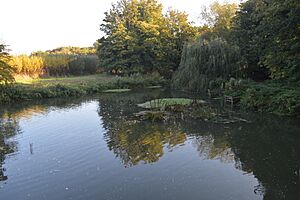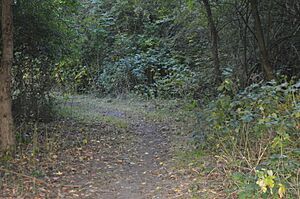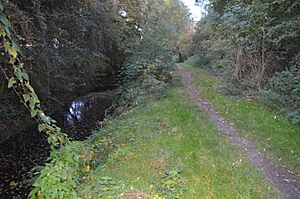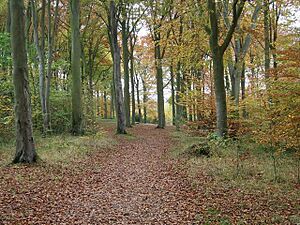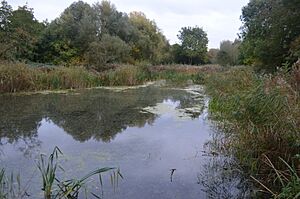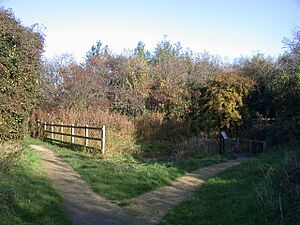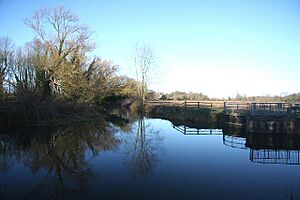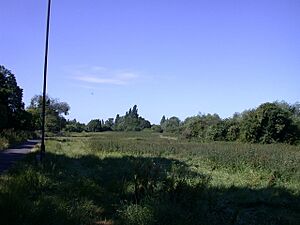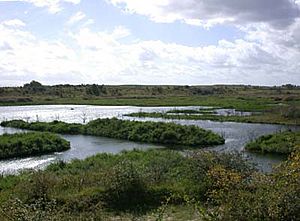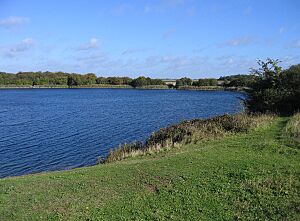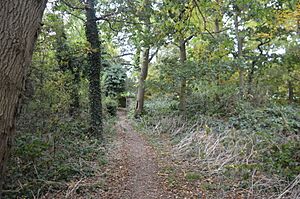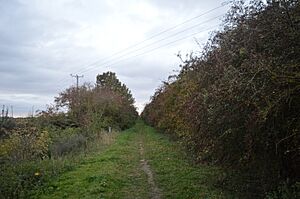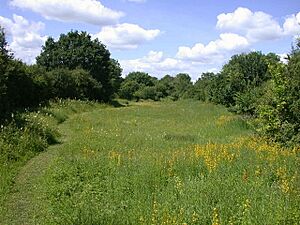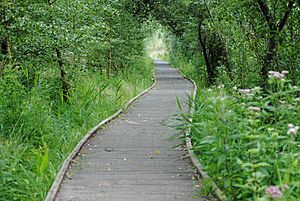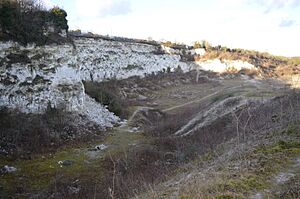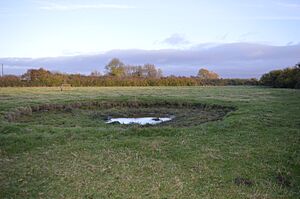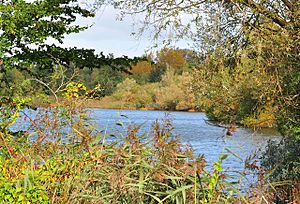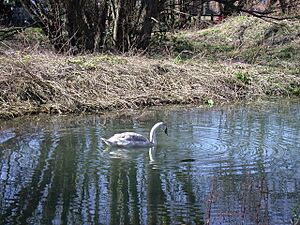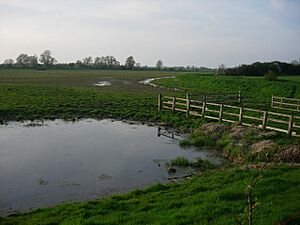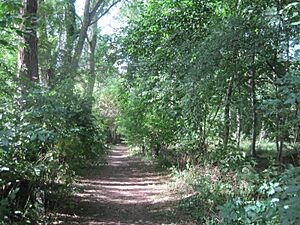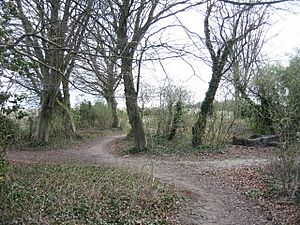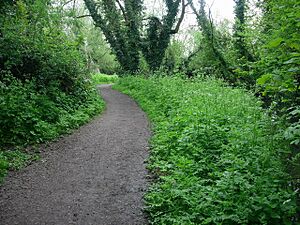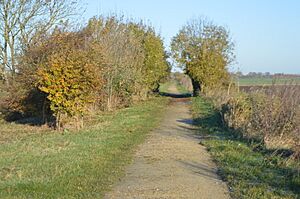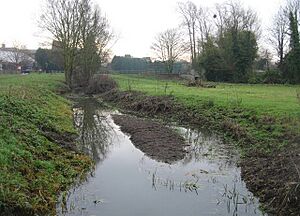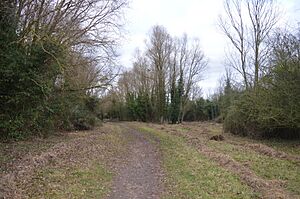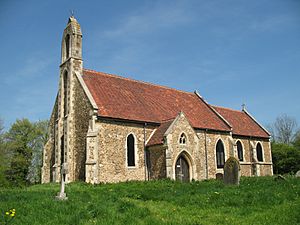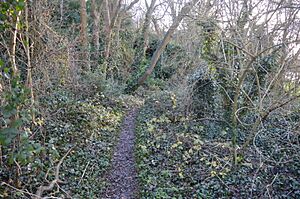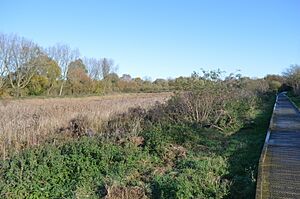List of local nature reserves in Cambridgeshire facts for kids
Cambridgeshire is a county in eastern England. It covers about 1,308 square miles (3,388 square kilometers) and had a population of 708,719 people in 2011. Two big rivers, the Nene and the Great Ouse, flow through it. Peterborough is a main area for making things. The famous University of Cambridge, started in the 1200s, made the county a very important place for learning. A large part of Cambridgeshire is in an area called The Fens. This wet land was drained over many years, starting in Roman times and mostly finished by the 1600s. This made much more land available for farming.
The way Cambridgeshire is governed changed in 1974. It now includes most of the historic area of Huntingdonshire. Local government is split between the Cambridgeshire County Council and the Peterborough City Council. Peterborough is a separate council that manages its own area. Under the county council, there are five smaller councils: Cambridge City Council, South Cambridgeshire District Council, East Cambridgeshire District Council, Huntingdonshire District Council, and Fenland District Council.
Contents
- What are Local Nature Reserves?
- Cambridgeshire's Special Nature Spots
- Explore Cambridgeshire's Nature Reserves
- Barnwell East
- Barnwell West
- Beechwoods
- The Boardwalks
- Bramblefields
- Byron's Pool
- Coldham's Common
- Dogsthorpe Star Pit
- Eye Green
- Grimeshaw Wood
- Isleham
- Kingston and Bourn Old Railway
- Lattersey Field
- Limekiln Close and East Pit
- Little Downham
- Little Paxton Pits
- Logan's Meadow
- Mare Fen
- Melwood
- Nine Wells
- Paradise
- Ring's End
- Sheep's Green and Coe Fen
- Somersham
- St Denis Church (footprint of church only)
- West Pit
- Woodston Ponds
- See also
What are Local Nature Reserves?
Local nature reserves (LNRs) are special places for nature that local councils set aside. Councils must have control over these sites, either by owning them, renting them, or having an agreement with the owner. LNRs are important because they have special local interest for plants, animals, geology (rocks and land), or for education. Local councils can manage these sites themselves or work with groups like "friends of" organizations and wildlife trusts. They can also use local rules, called bye-laws, to protect and manage LNRs.
Cambridgeshire's Special Nature Spots
There are twenty-seven Local Nature Reserves in Cambridgeshire. Four of these are also Sites of Special Scientific Interest (SSSI), which means they are nationally important for their wildlife or geology. Five of the LNRs are looked after by the Wildlife Trust for Bedfordshire, Cambridgeshire and Northamptonshire. The biggest LNR is Little Paxton Pits, which is 60 hectares (about 148 acres). It's super important for wild birds that visit in winter. The smallest is St Denis Churchyard, East Hatley, which has a variety of different flowers in its grassland. You can visit all of these special places!
Explore Cambridgeshire's Nature Reserves
Barnwell East
This reserve has woodlands, a pond, bushy areas (scrub), and grasslands. You can find plants like blackthorns, hawthorns, and even beautiful bee orchids. Birds like blackcaps and willow warblers live here, and you might see common blue and meadow brown butterflies fluttering around.
- Area: 2.6 hectares (6.4 acres)
- Location: Cambridge
Barnwell West
This long, narrow reserve follows Coldhams Brook. It's managed to help water voles thrive. Birds such as kingfishers, redwings, and fieldfares can be seen. Butterflies like speckled woods and orange tips also visit this site.
- Area: 3.8 hectares (9.4 acres)
- Location: Cambridge
Beechwoods
Beech trees were planted here in the 1840s on old farmland. You can still see traces of medieval ploughing! Birds like green and great spotted woodpeckers, and nuthatches make their homes in these woods. This site is managed by the Wildlife Trust for Bedfordshire, Cambridgeshire and Northamptonshire.
- Area: 9.8 hectares (24 acres)
- Location: Cambridge
The Boardwalks
This reserve runs along the north side of the River Nene. It has ponds filled with water beetles, frogs, toads, and smooth newts. Bats live in the big willow trees, and you can spot birds like herons and woodpeckers.
- Area: 7.8 hectares (19 acres)
- Location: Peterborough
Bramblefields
Even though it's in the middle of a neighborhood, this site has grasslands, scrub, and a pond. The pond is home to amphibians like frogs and newts. Birds such as song thrushes can be heard singing here.
- Area: 2.1 hectares (5.2 acres)
- Location: Cambridge
Byron's Pool
This place is named after the famous poet Lord Byron, who used to swim in the pool. It's a long pond with woodlands next to the River Cam. You might see little grebes and grey wagtails. There are also frogs, butterflies, and colorful dragonflies and damselflies.
- Area: 4.4 hectares (11 acres)
- Location: Grantchester
Coldham's Common
This large site has areas of natural grassland with anthills made by yellow meadow ants. There are also bushy areas and woodlands. Plants like spiny rest harrow, upright brome, and bee orchid grow here.
- Area: 49.3 hectares (122 acres)
- Location: Cambridge
Dogsthorpe Star Pit
This used to be a brick pit. It's now a Site of Special Scientific Interest (SSSI) because of its many invertebrates, especially water beetles. There are 64 types of water beetles, including 4 that are on the IUCN Red List of threatened species. This site is managed by the Wildlife Trust for Bedfordshire, Cambridgeshire and Northamptonshire.
- Area: 36.7 hectares (91 acres)
- Location: Peterborough
Eye Green
This site was also a brick works, and now a large lake fills much of the area. Reeds and bushes grow along the shore, providing shelter for water birds like coots and moorhens. Small birds like dunnocks and great tits nest in the thick bushes. There are also many different flowers and insects.
- Area: 12.0 hectares (30 acres)
- Location: Eye Green
Grimeshaw Wood
This site is an ancient woodland, split into three connected areas. You can find nettle-leaved bellflowers growing here, and pipistrelle bats live in the woods.
- Area: 16.8 hectares (42 acres)
- Location: Peterborough
Isleham
This reserve is a section of an old railway line. It has grasslands and hedgerows with a wide variety of plants and animals. You can see flowering plants like field scabious, greater knapweed, St John's wort, wild marjoram, and bladder campion.
- Area: 1.1 hectares (2.7 acres)
- Location: Isleham
Kingston and Bourn Old Railway
The sides of this old railway bank are covered in woodland, with ash, field maple, and oak trees. The top of the bank has natural grassland. There's also a wet area with old willow trees.
- Area: 1.9 hectares (4.7 acres)
- Location: Toft
Lattersey Field
This used to be a clay quarry, and now its pits are filled with water. It has many different habitats, including grasslands, woodlands, scrub, pools, marshes, and reedbeds. Mammals like water voles and water shrews live here. Birds such as sedge warblers, tawny owls, woodcocks, great spotted woodpeckers, and reed buntings can be found. This site is managed by the Wildlife Trust for Bedfordshire, Cambridgeshire and Northamptonshire.
- Area: 11.9 hectares (29 acres)
- Location: Whittlesey
Limekiln Close and East Pit
These two parts of the site were once chalk quarries. East Pit has steep chalk walls and a base with wildflower grasslands and some scrub. Flowers include milkwort, harebell, kidney vetch, and the rare moon carrot, which is on the British IUCN Red List of threatened species. Quarrying stopped in Limekiln Close 200 years ago, and it's now a steep, mature woodland with ash and cherry trees. This site is a Site of Special Scientific Interest (SSSI) and is managed by the Wildlife Trust for Bedfordshire, Cambridgeshire and Northamptonshire.
- Area: 11.0 hectares (27 acres)
- Location: Cherry Hinton
Little Downham
This site has three areas: Pingle Wood, Myles Meadow, and The Holts. Myles Meadow has two ponds and is grazed by cattle at certain times of the year. Holts Meadow has a pond with many dragonflies and damselflies, including the large emperor and the less common scarce chaser dragonflies.
- Area: 6.6 hectares (16 acres)
- Location: Little Downham
Little Paxton Pits
These old gravel pits are now flooded and are very important for wild birds that spend the winter here, especially gadwalls. There are also several rare types of flies, like Spilogona scutulata and Lispocephala falculata. Plants include common spotted-orchids and hare's-foot clover. This site is a Site of Special Scientific Interest (SSSI).
- Area: 60.0 hectares (148 acres)
- Location: Little Paxton
Logan's Meadow
This reserve is on the bank of the River Cam. It has pasture land where you can see tortoiseshell and comma butterflies, and flowers like cow parsley and cuckoo flowers. In autumn, starlings gather in the trees to roost. You can also find freshwater mussels in the river.
- Area: 1.1 hectares (2.7 acres)
- Location: Cambridge
Mare Fen
This pasture is in the floodplain of the River Great Ouse. It's used for grazing in summer and allowed to flood in winter. You can see wild birds like mute swans, wigeons, teal, and shovelers. Mammals include badgers and muntjac deer. There are also many different water plants.
- Area: 16.3 hectares (40 acres)
- Location: Swavesey
Melwood
This woodland is next to the River Mel. It has trees like ash, hawthorn, sycamore, beech, and silver birch. On the ground, you'll find plants like dog violet and cow parsley. Traveller's joy provides food for moths. Tawny owls and pipistrelle bats roost in the ivy here.
- Area: 0.6 hectares (1.5 acres)
- Location: Meldreth
Nine Wells
The springs in this beech wood feed Hobson's Conduit, which used to provide clean drinking water to Cambridge. This site was once a Site of Special Scientific Interest (SSSI) because of its rare invertebrates, but these were lost during a dry period in 1976. Over 108 different types of plants have been recorded here.
- Area: 1.2 hectares (3.0 acres)
- Location: Great Shelford
Paradise
This reserve is on the west bank of the River Cam. It has marshland and wet woodland with old willow trees. Plants like butterbur grow here, and the reserve is home to the uncommon musk beetle, which lays its eggs in the willows.
- Area: 2.2 hectares (5.4 acres)
- Location: Cambridge
Ring's End
This is a long, narrow reserve along an old railway embankment, offering views over The Fens. It also has three ponds, reedbeds, and bushy areas. The soil here doesn't have many nutrients, which allows uncommon flowering plants like coltsfoot to grow well.
- Area: 8.5 hectares (21 acres)
- Location: March
Sheep's Green and Coe Fen
These grazing grounds on the banks of the River Cam flood at certain times of the year. You can see waterfowl like egrets, kingfishers, and herons. The number of water voles is growing here. There are also many old willow trees.
- Area: 16.9 hectares (42 acres)
- Location: Cambridge
Somersham
This reserve has a lake, wetlands, grasslands, and woodlands. You might find reptiles like grass snakes and common lizards. Birds such as great crested grebes live here, and plants like red bartsia and purple loosestrife grow in the area.
- Area: 8.9 hectares (22 acres)
- Location: Somersham
St Denis Church (footprint of church only)
The churchyard here is mostly neutral grassland, but some parts are chalky. It has a wide variety of grasses and flowers. Flowers include hoary plantain, rough hawkbit, and oxlip.
- Area: 0.02 hectares (0.049 acres)
- Location: Hatley
West Pit
This used to be a chalk quarry and is now a steeply sloped woodland with a caravan park in the middle. The woodland is a Site of Special Scientific Interest (SSSI) because it has a plant on the British IUCN Red List of threatened species, the moon carrot.
- Area: 4.3 hectares (11 acres)
- Location: Cherry Hinton
Woodston Ponds
This site was once used for ponds to clean sugar beet washings. The east side has a lake with water birds like grey herons, tufted ducks, and pochards. In the west, there's a reedbed with pools and channels, home to great crested newts and unusual types of water beetles. This site is managed by the Wildlife Trust for Bedfordshire, Cambridgeshire and Northamptonshire.
- Area: 8.9 hectares (22 acres)
- Location: Peterborough
See also


